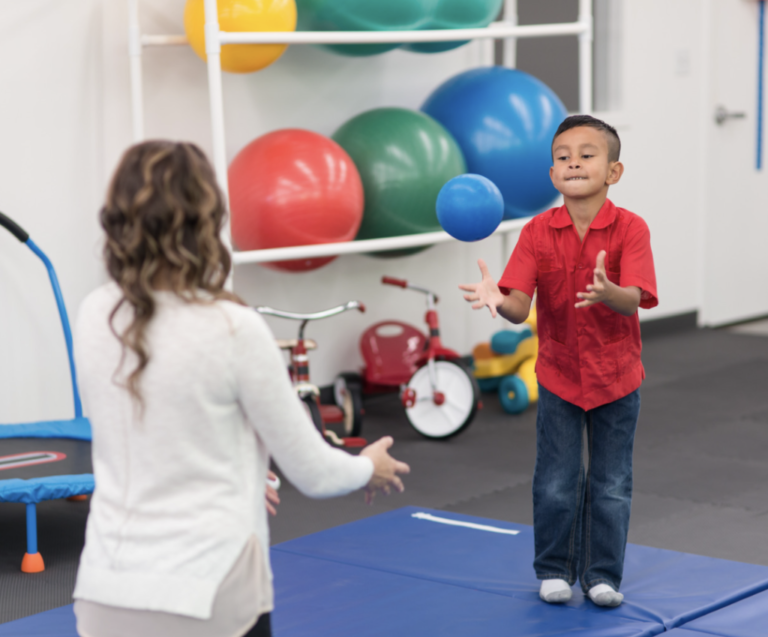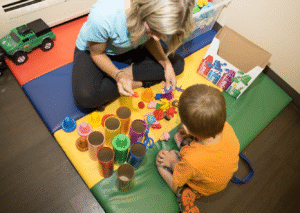Attention, regulation and impulse control do not occur automatically for children with Attention-Deficit/Hyperactivity Disorder (ADHD). This can result in behavioral issues, poor social skills, anxiety, and depression. Through learning about the four levels of the brain, you can understand how the levels all become connected to improve attention, learning, social interaction, regulation and overall function for life skills.
The brain is complex. But by learning how your child’s brain works, you can target and improve these specific areas with different activities and exercises. Understanding how reflex integration helps with children with ADHD gives your child the opportunity to re-establish lower foundations of brain development that help to establish new connections to higher levels of brain function.

In previous blogs, we explored the layered processes of learning, known as the brain hierarchy. Please refer to “How Reflex Integration Helps with Sensory Processing” Each part of the brain builds on the other as the brain develops new connections through sensory experiences, motor planning and cognitive development.
In order for the brain to work at its maximum capacity, all four levels need to coordinate with each other to assist with learning and attention. The stability of lower levels allows the higher levels to function properly.
For example, a child with poor body awareness won’t be able to sit still and focus in class. To address this, we first work on improving the child’s body awareness before focusing on attentiveness and the ability to sit still in class.
ADHD Training and Treatment
Licensed physical, occupational and speech therapists at Crawl Walk Jump Run Therapy Clinic offer diverse training and treatment for ADHD. Here are some treatments within each stage of brain development that our therapists can provide.
Treatments within the Foundational Stage of Brain Development include exercises for both sensory and motor needs, implementing a better sleep routine, pursuing testing or food intolerances, and implementing a predictable daily routine.
ADHD Training
- Daily routine and bedtime routines: Establishing routines reduces unexpected changes throughout the day. Children with ADHD are more likely to exhibit increased behaviors when their environments lack structure and predictability.
Regulation Stage
Treatments in the Regulation Stage of Brain Development include introducing a sensory diet, swinging and other vestibular input, brushing and joint compressions, the use of essential oils, CranioSacral Therapy and passive reflex integration exercises.
- Sensory diet: creates a schedule tailored for each child’s individual sensory needs. An occupational therapist can help assist with creating various sensory activities to follow throughout the day. For example, your child can begin the day eating a crunchy cereal for breakfast for oral input or jumping for body awareness before having to focus on school.
- Swinging and other vestibular input: vestibular movements provide information about where the body is in space and whether or not our surroundings are moving. Slow, linear rocking can help calm a hyperactive child, which will increase their focus and attention for educational and daily activities,whereas fast, rotational movements create an altering/excitatory response in a child’s nervous system, which can help arouse and awaken children.
- Brushing and joint compressions: provide tactile and proprioceptive input to the body, helping children understand where their body is in space and focus on functional and learning tasks.
- Essential oil: provides olfactory stimulation, which is your sense of smell. Applying different oils topically can either calm or stimulate the body, depending on their properties.
- Craniosacral Therapy: uses light hands-on pressure at specific points in the body. This can regulate the body’s Craniosacral system, which consists of the cranial bones, bones of the spine, membranes surrounding the brain and spinal cord, cerebral spinal fluid and fascia throughout the body. It improves whole-body health and performance and is directly related to the central nervous system and the musculoskeletal systems.
- Reflex Integration: uses a sequence of exercises that retrain your body’s primal reflexes, which may have become unintegrated, lost, or underdeveloped due to factors like age, stress, sensory sensitivities, injuries, or trauma. Therapists help the child integrate much-needed reflex patterns which can help with fluidity of movement, language, attention, speech, sensory needs, anxiety, and more.
Sensorimotor Stage
In the Sensorimotor Stage of Brain Development, treatment techniques involve Therapeutic listening, oral motor work, exercises that promote stretching and strengthening, astronaut training, Brain Gym and Reflex Integration exercises.
- Therapeutic Listening: a program used when addressing sensorimotor needs as it has organized sounds that the child progresses through. Therapeutic Listening has many benefits such as increased self-regulation, increased focus and attention, and increased fine and gross motor skills.
- Oral Motor Work: This treatment works on stimulating the oral cavity and jaw with different flavor options and textures. This stimulates the senses, desensitizing the mouth to provide sensory stimulation for children who need increased focus.
- The Universal Exercise Unit: Crawl, Walk, Jump, Run’s unique therapy approach focuses on stretching and strengthening by placing the child in various positions. The pulley system isolates and strengthens specific muscles, preventing compensation from other muscle groups. Check out our website for more information.
- Astronaut training: This program consists of activities for different movements, exercise-specific CD’s to address the auditory system, and visual light pen exercises to work the visual system. The vestibular activities use movements to activate all three semicircular canals of the vestibular system, resulting in improved regulation, body awareness, and overall bodily movement.
- Brain Gym: often seen in correlation with The Universal Exercise Unit at Crawl, Walk, Jump Run Therapy Clinic. This consists of a series of exercises that utilize the movements naturally completed in the first years of life, which help coordinate the eyes, ears, hands and whole body. The ability to do these activities relies on cross brain communication, challenging your right and left side to work together.

ADHD Treatments
Treatments in the Perceptual Motor stage of Brain Development include vision therapy, interactive metronome, and Bal-A-Vis-X, among others.
- Vision Therapy: helps to reduce visual issues such as tracking difficulties, convergence difficulties or ocular fatigue which can cause impulsivity, avoidance of fine motor tasks, distractibility and academic difficulties.
- Interactive Metronome: a neurological assessment and treatment tool that can improve cognitive, communication, behavioral and motor deficiencies for those with auditory and sensory processing difficulties, dyslexia and other learning disorders, autism spectrum disorders, ADHD and more.
- Bal-a-Vis-X: a program that uses bean bags and Bal-A-Vis-X balls to increase hand-eye coordination and the ability to move one item from one side of your body to the other.
Treatments within the highest stage of brain development called the Stage of Automaticity of Intention and Engagement include activities of daily living and Handwriting Without Tears.
- Handwriting Without Tears: this program works to help children with developmentally appropriate and multisensory strategies for writing that will become second nature to them. This approach involves children moving, touching, feeling and manipulating real objects as they learn the habits and skills essential for writing with the use of workbooks and a unique letter order for teaching.
Upon reaching automaticity of intention and engagement, the highest level of neurodevelopment, your brain is now ready to focus on progressing its working memory, fine motor skills and behavior.
Every child may start at a different level of neurodevelopment and that is okay. At Crawl, Walk, Jump, Run Therapy Clinic, it is our job to work with your child, family, and physicians to establish the right plan of care to meet and exceed your child’s goals to maximize their learning and development. Let our team of experts put a treatment plan together for your child to help them live their best lives!
Stay tuned for our next blog on how reflex integration can help specifically for emotional regulation, focus and processing through the integration of the Fear Paralysis reflex.




